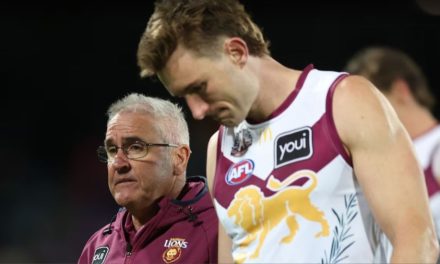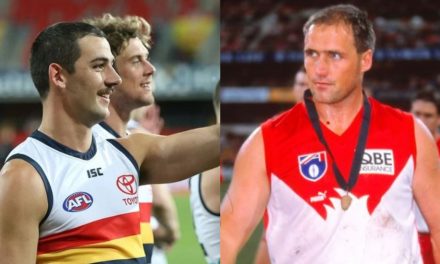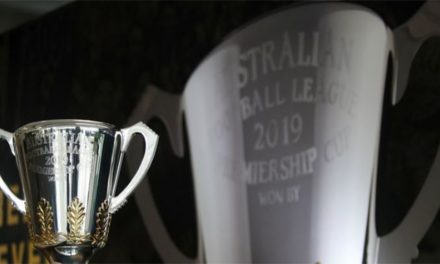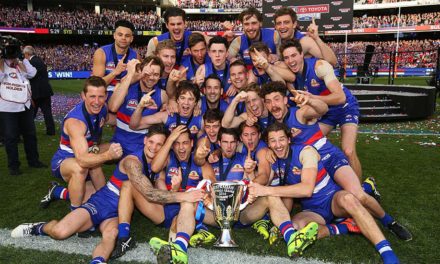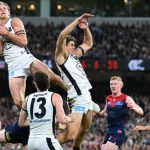Richmond’s 300 club: Kevin Bartlett, Shane Edwards, Jack Dyer (statue), Francis Bourke, Jack Riewoldt. Photo: GETTY IMAGES
Richmond’s Shane Edwards will play his 300th AFL match on Sunday at the MCG. He will become just the fifth Richmond player to achieve the feat, joining club immortals in Kevin Barlett, Jack Dyer, and Francis Bourke, as well as long-time teammate Jack Riewoldt.
He will also become the eighth Indigenous player to reach what is the game’s most distinguished milestone.
Edwards, an Arrernte man from Golden Grove in South Australia, has borne witness to a changing Richmond Football Club in just about every way imaginable. Some of it has happened around him, but plenty of it because of him.
Through Richmond’s recent glory years and the chimeric lead up, Edwards was a quiet achiever. One whose brilliance would make fans huddle in just that bit closer to discuss. Not a secret, exactly, but it was somewhat satisfying that we all knew how good he was before anyone else did.
Indeed, he eventually featured in so many “most underrated player in the league” discussions that it almost went the other way, and some imperceptive members of the football community were aghast when he cracked an All-Australian side in 2018.
Simply put, Edwards is reliably beloved by the Richmond faithful, with brass-bound loyalty in both directions. But it was not always this way.
Often, when I notice friends or strangers lamenting (a gentle word in the majority of these circumstances) the performance of a flawed player on their team, I think about Edwards, and how unlikely his career seemed a decade ago.
He arrived at the end of 2006 weighing 65 kilograms and looking a good four years away from being able to get a kick. That he debuted the following season was a good effort, but also a reflection of the Tigers’ lowly standing in 2007, a season in which they would claim their second wooden spoon in four years.
Over the next five-or-so seasons, Edwards was in the ones most weeks, but a long way off the player he became.
The odd flourish, that good judges may have read as a harbinger of his later magnificence, was often outweighed by a bad shank in the forward half. He seemed to regularly miss goals from the goal square. The 2011 season was particularly grim on that front, with four goals and 11 behinds for the year.
Ultimately, I did not see a position for him in a contending Richmond side, and I certainly wasn’t alone in that.
How unbelievably, delightfully wrong. His journey since then has been an instructive example of year-on-year improvement, and an indication to every fan that even players about whom you’re most sceptical can end up as club greats.
The latter half of Edwards’ career has been a wonder. As he got a little bit better each season from 2012 onwards, so did the Tigers. As he established himself as a genuine gun of the AFL in 2017, Richmond began winning flags.
PLEASE HELP US CONTINUE TO THRIVE BY BECOMING AN OFFICIAL FOOTYOLOGY PATRON. JUST CLICK THIS LINK.
He is simply unbelievable in traffic. Most footballers are instantly dispossessed when they run into a gaggle of opposition players, but Edwards does it on purpose to lure the pack towards him, before firing out a look-away handball to the suddenly unmarked teammate in the middle of the ground.
In 2018, his best year, he led the league in metres gained by handball with nearly double the next best. He is one of the best at the craft in modern footy, and his ability to open up space by picking off a surprise target with an angular handpass is the essential part of Richmond’s irrepressible ball movement. Often these are distributed over his head.
He either possesses incredible vision, or pays more attention than other players. Goal assists, a measure in which he has consistently ranked highly, frequently come from lasering a pass across the forward 50 away from goal. Camera operators are forever chasing his innovative decisions.
He’s still not big, but he doesn’t need to be, because he’s wily. And he knows what’s going to happen before everyone else. When fighting for a contested ball, he inspires just as much faith as Trent Cotchin or Tom Lynch. And he’s now a comfortingly reliable set shot for goal.
He also relishes big games, polling Norm Smith Medal votes in 2017 and 2020, and he was among Richmond’s best also on grand final day in 2019.
Since 2012, he has regularly saved his best performances for the annual Dreamtime game. That year, Edwards was the only Indigenous person in Richmond’s line-up. Drafted into a team with only a handful of Indigenous players, he saw the vast majority depart within his first few seasons.
As recently as a decade ago, Punt Road was not a place renowned for its celebration of First Nations culture, nor its retention of Indigenous talent. As Edwards himself pointed out earlier this year: “I got here 16 years ago and there was no support for Indigenous players. It was ‘get drafted, good luck to you’.”
Now, the opposite is true.
Edwards has undoubtedly played a key role in this, having undergone his own well-documented journey in this regard to now sit comfortably as the elder statesman of a strong, connected group of young Indigenous people.
His leadership, standing within the club, and on-field prowess, meant that when these players arrived at Richmond, there was already a solid cultural conduit within the group. The success of the club’s Korin Gamadji Institute, which Edwards helped launch 11 years ago, may not have occurred without such a figure from among the playing ranks.
Edwards’ story is one of steady improvement all the way up to a wonderful pinnacle, with an off-field narrative to match. Perhaps no other player is as emblematic of the modern Richmond odyssey than him.
Sunday will be an awesome celebration. And for new appreciators and old, also a great opportunity to get the binoculars out, and observe the splendours still being produced by Richmond’s number 10.


